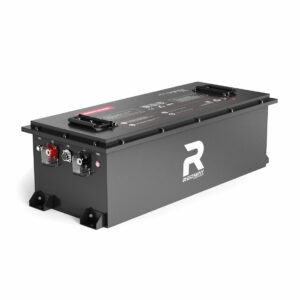How Can You Maximize Your RV Battery’s Lifespan with Effective Maintenance?
How can you optimize an RV battery’s lifespan? Regular maintenance, including cleaning terminals, avoiding deep discharges, proper charging, monitoring electrolyte levels (for lead-acid batteries), and temperature control, extends RV battery life. Using a smart charger, installing a battery monitor, and selecting the right battery type also enhance performance. Seasonal storage practices and avoiding overloading circuits further prevent premature degradation.
Maintaining RV Batteries for Longevity & Efficiency
How Does Regular Cleaning Prevent RV Battery Corrosion?
Dirt and corrosion on terminals increase resistance, reducing efficiency. Clean terminals with baking soda and water, then apply dielectric grease to prevent future buildup. Inspect cables for wear monthly. This minimizes energy loss and ensures stable connections.

Why Is Avoiding Deep Discharges Critical for Battery Health?
Discharging below 50% capacity strains lead-acid batteries, causing sulfation. Lithium batteries tolerate deeper discharges but degrade faster below 20%. Use a battery monitor to maintain charge above 50% and recharge promptly after use.
Sulfation occurs when lead sulfate crystals form on battery plates during prolonged discharges. These crystals reduce active material availability, permanently lowering capacity. For example, a 100Ah lead-acid battery discharged to 20% daily may lose 30% of its capacity within 12 months. In contrast, lithium iron phosphate (LiFePO4) batteries experience minimal sulfation but face electrolyte decomposition when discharged below 10%. A voltage cutoff of 11.5V for lead-acid and 12V for lithium prevents irreversible damage.
Key Factors Affecting RV Battery Lifespan
| Battery Type | Safe Discharge Limit | Cycle Life at Limit |
|---|---|---|
| Flooded Lead-Acid | 50% | 300-500 cycles |
| AGM | 60% | 500-700 cycles |
| Lithium | 80% | 3,000-5,000 cycles |
What Charging Practices Extend RV Battery Life?
Use a three-stage smart charger to avoid overcharging. Charge at 10–30% of battery capacity (e.g., 10A for 100Ah). Equalize lead-acid batteries quarterly to balance cells. Never charge frozen batteries. Lithium batteries require constant-voltage chargers.
How Do You Maintain Water Levels in Flooded Lead-Acid Batterions?
Check electrolyte levels monthly. Top up with distilled water, ensuring plates remain submerged. Overfilling causes acid spills. Wear gloves and safety goggles. Avoid tap water—minerals reduce conductivity.
When Should You Use a Battery Monitoring System?
Install a monitor to track voltage, charge cycles, and discharge depth. Alerts for low charge prevent accidental drains. Monitors optimize charging schedules and identify failing cells early. Essential for dual-battery setups.
Which Storage Practices Protect RV Batteries Off-Season?
Store at 50–70% charge in a cool, dry place. Disconnect terminals to prevent parasitic drains. For lead-acid, recharge every 3 months. Lithium batteries retain charge longer but store better at 30–60%. Use a solar trickle charger if leaving connected.
What Are the Benefits of Lithium vs. Lead-Acid RV Batteries?
Lithium batteries last 2–3x longer (3,000+ cycles vs. 500), tolerate deeper discharges, and charge faster. They’re lighter but cost 3x more. Lead-acid suits budget users; lithium excels for frequent boondocking.
Lithium’s weight advantage is critical for RVs—a 100Ah lithium battery weighs 30 lbs versus 60-70 lbs for lead-acid. This reduces overall vehicle load, improving fuel efficiency by 2-3%. While upfront costs are higher ($900 vs. $300 for 100Ah), lithium’s 10-year lifespan versus 3-5 years for lead-acid results in lower long-term costs. Temperature resilience also differs: lithium operates at -20°C to 60°C, while lead-acid loses 50% capacity below -10°C.
| Feature | Lithium | Lead-Acid |
|---|---|---|
| Cost per Cycle | $0.15 | $0.35 |
| Charge Time (0-100%) | 2-4 hours | 8-10 hours |
| Recyclability | 95% | 99% |
Expert Views
“Modern RVers often overlook temperature’s impact on batteries. Lithium-ion cells lose 20% capacity at -4°F but thrive in heat. Lead-acid batteries suffer plate corrosion above 90°F. Always insulate batteries in extreme climates and prioritize ventilation.”
— Redway Power Solutions Engineer
Conclusion
Optimizing RV battery lifespan demands proactive maintenance tailored to battery chemistry. Combine cleaning, smart charging, and monitoring with climate-conscious storage. Upgrade to lithium for heavy usage, but maintain lead-acid systems rigorously. These strategies prevent 80% of premature failures, saving costs and ensuring reliable power during travels.
FAQs
- How often should I test my RV battery’s charge?
- Test voltage monthly using a multimeter. Lead-acid should read 12.6V+ (full), 12.4V at 75%. Lithium ranges from 14.6V (charging) to 12.8V (resting).
- Can I replace my RV’s lead-acid battery with lithium?
- Yes, but upgrade the charger and electrical system. Lithium requires higher voltage thresholds and may need a DC-DC converter for alternator charging.
- Do RV solar panels extend battery life?
- Yes—solar maintains optimal charge during storage and reduces generator use. Pair with a charge controller to prevent overvoltage.
